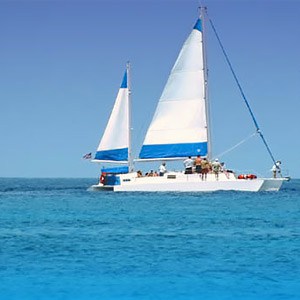Please Register / Login to take part in discussions about the Virgin Islands.
I spent most of this past weekend hiking in St. Croix’s northwest forest. What I saw on Sunday confirmed what I had seen Saturday: Vast stretches of the forest are becoming inaccessible to the public because roads are caving in and trails are reverting to impenetrable thickets.
I’m not talking about the Mahogany Road and Creque Dam Road, which are in pretty good shape. I mean the remote area north of there were the Western Scenic Road is (still intact) and was (now washed away and closed to vehicles).
I have mixed feelings about this. On the one hand, I want visitors and locals to be able to see the remarkable mountaintop views. On the other hand, I don’t want developers in there.
Some of you probably know that most of the Western Scenic Road has been closed for some time. I hiked the abandoned far western stretch on Sunday, starting at the west end near the beach and going east. It’s incredibly steep until you get to the ridge. Chunks of it are falling over the cliffs. There’s really nothing to see, even at the former pullovers, since tan-tans and Ginger-Thomases along the roadside block the view. It’s like walking through a tunnel in most parts. However, once you get to the eastern edge of this stretch, just north of Creque Dam Road, you can hike up a short, overgrown drive to a grassy mountaintop, where you get an incredible view looking out for miles over the whole area.
The Scenic Road is also washed out in the Mount Eagle/Blue Mountain area. While hiking along it about three months ago, I was stopped by a gap 50 feet wide and deep where a landslide had occurred. I tried from the other side of the mountain, and that, too, has a gap. There may be other gaps in between these two. Consequently, you can't go up into Mount Eagle, St. Croix's highest mountain, and see the view. Again, vegetation along the roadside blocks most of the view along the way.
On Saturday, I tried climbing the trail to the lighthouse on Ham Bluff, but was halted by overgrown tan-tans. One section of the Furnel Ridge Trail, just above Wells Bay and the Scenic Western Road, which used to be a main hiking artery, no longer exists, having reverted to forest. Rather than hiking around in a loop, you now have to stop and backtrack through what you’ve already seen.
Still, on this hike, you can see Bodkin Mill, which at 960 feet is the highest sugar mill on St. Croix. The keystone above the entrance is inscribed ERECTED ANNO DOMINI 1808. A 17-year-old guidebook I have says the view from the mountaintop is spectacular, and that you can see 13 other mills from there. Guess what? The whole area is now overgrown with trees, and there is practically no view.
St. Croix is currently like two islands. Housing construction is booming on the East End. But the far northwestern end is going back in time. With each major storm, more sections of roads are lost, and more vegetation grows and turns trails into forest. I would love to hear any feedback you may have on this. I’m still trying to sort it out.
This is both good and bad, and probably more good. The human factor has been a strong detriment to some of the local species. In the late '70s and early to late '80s Iguanas were almost wiped out on STX; the little Cape Deer has almost been wiped out by illegal hunting and use of snares in "deh boosh". I also remember Orchid hunting trips, even thought strictly prohibited, that were done by some orchid enthusiasts. So, it's FANTASTIC in that sense. It's not as good that most people don't get to see the beauty that St. Croix has to offer. However, as with you, it sounds like if you put the time and effort into it, which removes most people who'd cause danger to the species and fauna, you'll be rewarded.
Hello F. Ohio Guy,
Have you checked into the St. Croix Environmental Association (SEA)
http://www.stxenvironmental.org/
Whether there are any efforts at maintaining the trails... or they may prefer seeing nature take over... They have various projects on-going on St. Croix.
Ras Lumumba Corriette of AyAy Eco Hike & Tours does hikes through his business and also with SEA and other groups. He might be someone worth speaking with, the e-mail I have is [email protected], not sure if its current, or try (340)772-4079
--Islander
SGT,
I was not aware of the iguana, deer, and orchid situation. I have seen one deer on Creque Road.
Islander,
I have talked with two people from SEA, but not about this. I will check into it. I’ve also heard of Mr. Corriette. I think I’ll go on one of his hikes. He’s very knowledgeable, as is Olasse Davis, one of our local ecologists.
Here is a description of my hike up the Western Scenic Drive from near the beach:
The beginning of the road is dirt. About 100 feet up is the small Estate Ham sugar mill, which is largely buried in vegetation. It has four openings. There is no date inscribed above the entrance, only a keystone. There are some small banyan trees growing around the top that have sent down dangling roots that are about 10 to 15 feet long. You wonder how they can grow in what is primarily mortar and stone.
Higher up, the road becomes asphalt and is in good repair, but it is overgrown on both sides, so there is no view. Soon, it becomes very steep with chunks of pavement missing on the edges. Orange barriers that were placed on the road before it was closed are also falling over the cliffs.
The road then becomes weedy, broken concrete and extremely steep. Shrubs on both sides lean inward, creating a dark tunnel effect. It was cloudy and rainy at the time, which added to the gloomy effect.
Near the top of the first peak, the road levels off and again becomes dirt. Can’t they make up their minds? A dirt side road to the north leads to the top of the peak, which is very grassy and open with a good view of other nearby peaks and the sea. Two mills are visible on nearby Mount Washington.
About a quarter mile farther, you encounter another side road that is gated with two signs warning that if you trespass, you will be shot with questions asked later.
Then comes about a mile stretch that is flat, very overgrown, and badly eroded in places. It’s called Maroon Ridge, and is named after runaway or maroon slaves who used to hide out in the area. Near the end is a short quarter-mile spur on the north that you can hike up. It’s very grassy, open, and windswept, and the view of the northwest forest and sea is incredible.
You can also easily get to this viewpoint by car from Creque Dam Road (Route 58), the middle section of the Western Scenic Road (Route 78, which is open), or Route 765 off of Mahogany Road (Route 76). The spur parallels the western section of the Western Scenic Road.
I'm curious as to who owns the land there? A big chunk was owned by Fountain View of the '70s and current day Carambola's owners but I don't think it extended anywhere close to where your hike took you. Lt. Gov's office should have records of the plats and ownership. Maybe if I feel really intrigued I'll check it out. I don't ever remember seeing Private Property signs out there but...........any thoughts FOG/Islander?
I've read about Fountain Valley and Carambola. The V.I. Government owns the Caledonia Gut. It's a territorial park. There are a few cattle ranches, some of which appear abandoned. Estates William and Punch are owned by William and Punch Partners and may become a resort. Estate Mount Washington is privately owned and has a restored greathouse with village ruins open to the public. Most of the land is a wildlife sanctuary.
As of 1999, it appeared that George "Jake" Jacobus of Delray Land Inc. owned the totally undeveloped (save for the trails) north coast from the Carambola Beach Resort (Davis Bay) to the lighthouse at Estate Ham:
http://webpac.uvi.edu/imls/np_uvi/odavis1999/history/carambola.shtml
Ol' Jake's indeed a gros chat! My god........I envy his assets [;-)) !
http://www.yourcommunityfoundation.org/pdfs/CF_Spr_2004NL.pdf
Thanks FOG!



